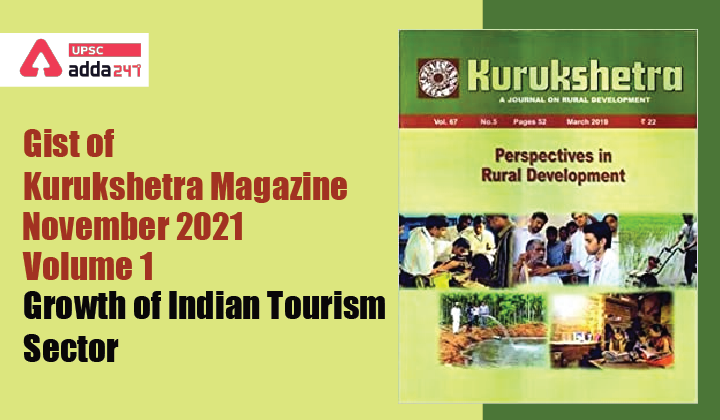Table of Contents
Introduction
- India’s glorious traditions and rich cultural heritage laid the foundation of the Indian tourism sector.
- India enjoys respect globally, with its distinct features of the richest culture and diverse heritage.
- The tourism sector contributes about 5 per cent to GDP and also creates direct and sustainable employment.
- It is witnessed that 1 out of 10 jobs created in India is from the tourism sector.
- India has been considered as the ‘Tourist Paradise’ because of its flora and fauna, architectural monuments, music, painting, art and crafts, dances, different cultures and languages, customs/traditions and varied festivals – which no other country in the world, can boost of and/or endowed with.
Importance of Tourism Sector In India
• Tourism sector is the fastest-growing and largest industry in terms of its economic benefits and socio-economic impacts and enabling equity.
• It contributes significantly to our economic growth by fostering new avenues of employment and subsequently contributes to the revenue generation of the economy.
• Tourism sector has a high multiplier effect in creating employment and enhancing income.
• It helps in the re-distribution of income and is a great tool of poverty reduction.
• It helps in bringing down the urban-rural disparity and rich-poor divide.
• It helps in integrated socio-economic development.
• scope and range of employment in the tourism sector is multi-faceted in nature, as it provides opportunities to all categories/ ages including young and old; educated and uneducated; male and female without any discrimination.
Growth Trends of Tourism Sector in India
• It was growing continuously from 2009-19.
• But Covid-19 has adversely impacted this sector for 15-18 months.
• Apart from that in the post-COVID period, if things improve, for sure the tourism sector will follow the trend of the past decade.
SWAN Analysis for the Tourism Sector in India
- The contribution of the tourism sector to the overall employment and livelihood itself signifies its importance in the development agenda.
- The government is committed to promoting the tourism sector for its multiplier effect and multi-faceted boosting-up of the economy.
- A critical ‘SWAN Analysis’ (S=Strengths, W= Weaknesses, A=Achievements and N=Next Steps) of the tourism sector in India is done to assess and to suggest the needful interventions and improvement.
COVID-19 Pandemic and Tourism Sector
- Due to the COVID-19 pandemic, the tourism sector suffered a serious setback for which the global tourism industry got a serious hit of US$ 4 trillion in terms of global GDP loss (2020 and 2021).
- As far as the tourism sector in India is concerned, it has been adversely affected in terms of its contribution to GDP and to direct and indirect employment, thus affecting millions of livelihoods.
Positive signs of after Covid Recovery
- India has the resilience and agility to bounce back, which is quite visible especially from August 2021.
- Although most of the socio-economic activities had slowed down earlier, they are picking-up life back in the post-COVID-19 regime, especially in the tourism sector.
- This is certainly a welcome sign of development.
- As a consequence, whatever the adverse impact is seen through poverty, inequality and joblessness in most parts of the world during COVID-19 (March 2020 to August 2021) is fading away.
Government’s Initiatives for Boosting the Tourism Sector
• Azadi Ka Amrit Mahotsav: India at 75 Years of Independence.
• Various schemes under Atmanirbhar Bharat- e.g. PRASHAD and Swadesh Darshan.
What is Swadesh Darshan Scheme?
• It is an initiative taken by the government to enrich the tourist experiences and to enhance opportunities and promote lesser-known destinations.
What is PRASHAD Scheme?
• National Mission on Pilgrimage Rejuvenation and Spiritual, Heritage Augmentation Drive (PRASHAD) launched by the Ministry of Tourism with a special objective of holistic development of pilgrimage and heritage destinations.
• Through this drive, 57 sites are identified in 29 states and union territories
Other schemes for tourism development
• Central Agencies for Tourism Infrastructure Development;
• Gap Scheme for Revenue Generating Tourism Projects;
• Capacity Building for Service Provider;
• Domestic Promotion and Publicity including Hospitality;
• Overseas Promotion and Publicity including Marketing Development Assistance;
• Champion Services Sector Scheme;
• Safe Tourist Destination for Women; and
• Development of Iconic Tourist Destination etc.
GOI’s Initiative to minimize the environmental and socio-cultural impact of tourism
• The concept of ‘Sustainable Tourism’ has been initiated.
• Government has already started new-age tourism which includes niche tourism to attract inbound and domestic tourists.
• The very purpose of the creation of ‘Sustainable Tourism’ is a kind of shift from ‘Seasonal Tourism’ to ‘365 Days Tourism’ and to meet the needs of the new customer segments
• The Government has already started new-age tourism which includes niche tourism to attract inbound and domestic tourists.
• Niche tourism undertaken includes cruise, adventure, wellness tourism, medical, golf and polo, film tourism, health tourism, heritage tourism, eco-tourism, rural tourism and sustainable tourism.
The Way Forward
- Tourists, whether domestic or international, look forward to the excellent infrastructure and high quality of hospitality services and more importantly the ‘great quality experiences to be treasured for years.
- The government needs to re-formulate and re-energise the tourism policy keeping in view the altering priorities of the tourists in the post-COVID-19 scenario.
- There is an urgent need to further strengthen- the core infrastructures like airways, railways roadways, and waterways etc., and also need to tighten security aspects.
- People’s participation must be encouraged at the local level.



 TSPSC Group 1 Question Paper 2024, Downl...
TSPSC Group 1 Question Paper 2024, Downl...
 TSPSC Group 1 Answer key 2024 Out, Downl...
TSPSC Group 1 Answer key 2024 Out, Downl...
 UPSC Prelims 2024 Question Paper, Downlo...
UPSC Prelims 2024 Question Paper, Downlo...





